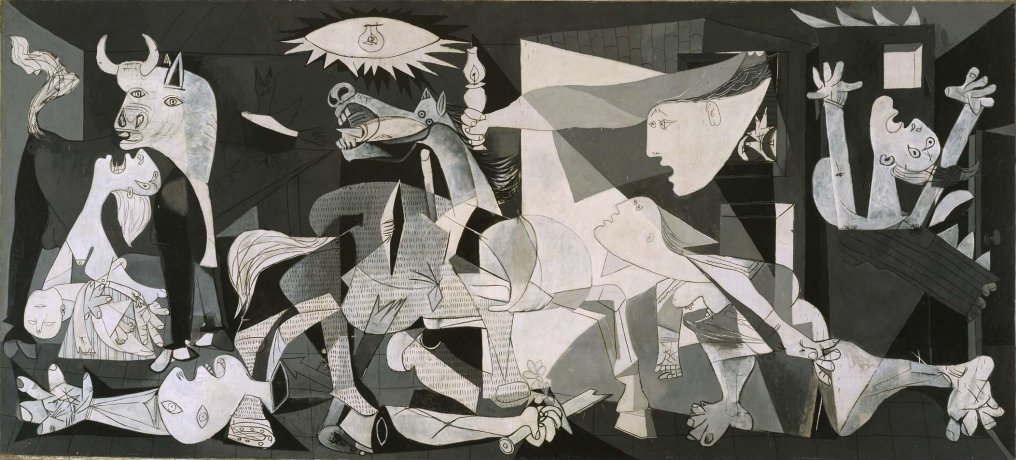
History remembers Pablo Picasso first as an innovative painter, and second as an uninhibited personality. The latter especially generated many an anecdote in his long life, some surely apocryphal but most probably true. A short Guardian editorial on one of his most famous canvases begins with the story of when, “in occupied Paris, a Gestapo officer who had barged his way into Picasso’s apartment pointed at a photo of the mural, Guernica, asking: ‘Did you do that?’ ‘No,’ Picasso replied, ‘you did’, his wit fizzing with the anger that animates the piece” — a piece that took no small amount of boldness to paint in the first place.
Guernica, much more of a visceral experience than the average painting, resists straightforward description, but the article offers one: “In black and white, the piece has the urgency of a newspaper photo. Flailing bulls and horses show that the visceral horrors of war are not just an affront to human civilisation, but to life.”
Painted in June 1937 at Picasso’s home in Paris, in response to the bombing by Nazi Germany and Fascist Italy of the Basque village from which the work would take its name, Guernica raised awareness of (as well as relief funds for) the Spanish Civil War when it debuted at the 1937 World’s Fair in Paris and subsequently toured the world itself.
Calling Picasso’s painting “probably the most successful artwork about war ever created,” Slate’s Noah Charney cites playwright Bertolt Brecht’s use of Verfremdungseffekt, or the “alienation effect,” wherein “the idea was to no longer encourage the traditional, Aristotelian approach that the audience of a play (or viewer of an artwork) should engage with the artwork/performance with a ‘willing suspension of disbelief,’ voluntarily pretending that what is happening on stage is real. Instead, Brecht wanted to make it clear that the audience was looking at a work of art, an artificial performance that nevertheless touches on real human emotions and issues.” Both Brecht and Picasso used this technique to effect social change with their work.
Guernica also challenges its viewers in the best way, looking almost playful at first glance but almost immediately demanding that they confront the horror it actually contains. “A realistic image of the bombing of the town of Guernica, with corpses and screams in the night, would likely have felt melodramatic, saccharine, difficult to look at,” writes Charney. “It might have been Romanticized or it might have been so gritty that our reaction would be to shut down our ability to sympathize, as a defense mechanism. The figures are almost cartoonish, but then of course, when you look more closely, when you know the context, they are not. But the childlike abstraction pulls us in, whereas the same subject, handled as a photorealist blood-fest, would repel us.”
You can learn more about Guernica, the events that inspired it, and the artist that turned those events into one of the most enduring images from the twentieth century with the short BBC News clip above, and also this chapter in Khan Academy’s online art-history course, this video primer and 3D tour, and Alain Resnais and Robert Hessens’ 1950 short film, almost as haunting as the painting itself. After all that, the only step that remains is to go see it in person at the Museo Nacional Centro de Arte Reina Sofía in Madrid, where it has resided since 1992. And though Guernica may now be safe from prying Gestapo hands, the need for vigilance against the kinds of destructive ideology that fired Picasso up to paint it will never go away.
Related Content:
A 3D Tour of Picasso’s Guernica
How to Understand a Picasso Painting: A Video Primer
The Mystery of Picasso: Landmark Film of a Legendary Artist at Work, by Henri-Georges Clouzot
Picasso Makes Wonderful Abstract Art
Watch Picasso Create Entire Paintings in Magnificent Time-Lapse Film (1956)
Based in Seoul, Colin Marshall writes and broadcasts on cities and culture. He’s at work on a book about Los Angeles, A Los Angeles Primer, the video series The City in Cinema, the crowdfunded journalism project Where Is the City of the Future?, and the Los Angeles Review of Books’ Korea Blog. Follow him on Twitter at @colinmarshall or on Facebook.


Hi Colin,
Some sentences just can’t be translated well/perfectly.
The Gestapo officer asked: “Haben sie das gemacht?” (= ‘made’, ‘created’, ‘painted’)
Picasso answered: “Nein, das haben Sie gemacht!” (= ‘done’)
So, if they would heven spoken English, this anecdote couldn’t even exist.
https://books.google.nl/books?id=nbQ2DAAAQBAJ&pg=PT176&lpg=PT176&dq=gestapo+“haben+sie+das+gemacht”
Harrie
There was also a great episode of the BBC In Our Time podcast on Guernica recently. It’s really good on the bombing itself, the stellar coverage of it by the journalist George Steer and the subsequent cover-up by the fascists (the Republican Basques bombed themselves apparently). It’s also full of great detail about how the picture was created.
http://www.bbc.co.uk/programmes/b09bxkdm
The Gestapo Points to Guernica and Asks Picasso, “Did You Do This?;” Picasso Replies “No, You Did!”
This quote was highlighted in a project I worked on with a few friends long time ago.
https://youtu.be/1iAJPoc23‑M?t=23m52s
https://www.facebook.com/popfind/videos/1440403776005017/
The exchange is perfectly correct both grammatically and conversationally, the German said “Haben she das gemacht he could also have been using the “do/done case of machen (the infinitive to the verb to do or to make)
This makes the question and the reply perfectly correct in English or in German.
Had that conversation really happened, the Gestapo would have shot him on the spot as was their habit, or else have sent Picasso to a concentration camp. So sickly-sweet as that fable is, it’s a lie.